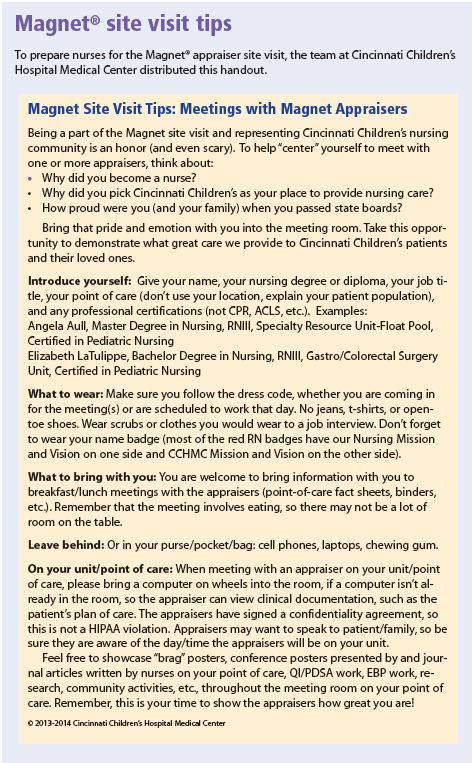At Cincinnati Children’s Hospital Medical Center (CCHMC), clinical nurses faced multiple challenges during a 6-week period in 2013:
- hospital-wide rollout of a new clinical pump
- triennial visit by The Joint Commission
- recent implementation of a new professional practice model
- impending upgrade of the electronic medical record
- American Nurses Credentialing Center’s Magnet Recognition Program® redesignation site visit.
What’s more, these events took place during a time of sustained high patient census. To ensure nurses felt supported and confident about the upcoming Magnet appraiser site visit and to build on existing knowledge, the hospital’s team responsible for preparing for the Magnet visit (the authors of this article) designed a boot camp to prepare them. The goal was to provide concentrated time and individualized attention so each unit could review its outcomes data and other unit-based projects 3 weeks before the site visit.
During boot camp week, we scheduled 30 1-hour sessions at multiple campuses where our patients receive care. Unit participation in boot camp was voluntary. Nurses chosen by their unit to meet with Magnet appraisers during the site visit were invited to attend boot camp, along with their clinical managers. In all, 237 nurses attended, exceeding our expectations.
All attendees were expected to arrive well-prepared—familiar with their latest unit data, such as nursing and patient satisfaction, nursing-sensitive indicators, and a unit-based, internally designed point-of-care fact sheet. Boot camp sessions took place in a centrally located conference room—not in a unit location, where nurses might be pulled away to care for patients.
Boot camp components
To cover all the necessary topics within the hour-long session, the team created an agenda with the topics Magnet appraisers were most likely to cover. Each session combined a presentation and discussion of the topics, which included the following:
- Data review (15 minutes). Discussion of point-of-care patient satisfaction and nursing-sensitive metrics. For non-inpatient areas, unit nurses were quizzed on which point-of-care data were included in the Magnet document. Depending on results, nurses discussed what was being done to improve, sustain, and share results with others and what action plans were in place in case of poor performance. If needed, participants discussed how to read a run chart (a graph of data over time).
- Interprofessional Practice Model (5 minutes). Review of CCHMC’s practice model. Nurses presented visuals depicting how their unit’s work demonstrated practice model components.
- Care delivery (5 minutes). Nurses described their unit’s care-delivery model (for instance, primary care, total patient care, functional nursing) with feedback or prompts.
- Magnet redesignation application document (5 minutes). Review of the Magnet redesignation application to ensure nurses were familiar with descriptions of their unit in the document.
- Point-of-care fact sheet (5 minutes). Review of the fact sheet—an at-a-glance look at how each unit exemplifies and demonstrates exemplary nursing practice on a quarterly basis.
- Quality improvement (QI), evidence-based practice (EBP), and research (5 minutes). Nurses were asked to distinguish among these three activities and to list the QI, EBP, and research activities occurring on their unit.
- General coaching tips (5 minutes). Review of how nurses should respond if they don’t know the answer to a Magnet appraiser’s question. (They should be honest, but state they know where to get the information if needed.)
- General topics (5 minutes). Review of how direct-care nurses on the unit participate in budget, staffing, scheduling, recruitment, retention activities, and ethics consults.
- What to have in the room when meeting with a Magnet appraiser (2 minutes). Photobooks, unit data graph displays, U.S. News & World Report ranking for the patient population
(if applicable), national awards for nursing excellence (such as the Lantern, Beacon, and DAISY awards), local awards for nursing excellence (Pease, Robison-Sporck, and Nightingale awards), publications by nurses, conference presentation abstracts, point-of-care EBP scholar projects, names of recent college graduates, newly certified nurses, and community activities. (See Magnet® site visit tips.)
The durations shown above for each agenda topic varied considerably depending on the unit’s needs.
Feedback on boot camp effectiveness
To elicit feedback on effectiveness, the team conducted a survey after boot camp and again after the Magnet site visit. We asked boot camp participants the following questions:
- How much did boot camp help you prepare for the site visit? All respondents indicated boot camp was at least somewhat helpful. The majority indicated it was “pretty helpful” or “extremely helpful” (66% pre-site visit; 61% post-site visit).
- Did you find boot camp a worthwhile investment of your time and resources? Before the site visit, 90% of respondents said yes; after the visit, 81% said yes.
- How much did boot camp affect your stress and fears about the Magnet site visit? Before the site visit, 57% reported stress relief; after the visit, 64% reported stress relief. A few participants reported boot camp made their stress and fears worse.
We also asked respondents to rate how important each discussion topic was. “Very important” ratings were ranked for the pre- and post-site visit surveys. Top-rated topics were patient satisfaction data, nursing satisfaction data, nurse-sensitive data, and general coaching on appraisers’ questions to which nurses didn’t know how to respond.
Implications for nurse leaders
Support from clinical leadership was imperative for our boot camp’s success. Clinical directors and managers arranged for coverage so nurses scheduled to work during their unit’s boot camp session could attend, even though their work schedules had been finalized weeks before they were invited to boot camp. Leaders’ recognition that boot camp attendance was important proved key to ensuring participants were prepared for the site visit.
Participation by clinical managers (CCHMC’s equivalent of assistant nurse managers) or clinical directors (our equivalent of nurse managers) also contributed to success. Presence of a management representative during boot camp to give a big-picture perspective and provide a history of unit activities (such as action planning around nurse satisfaction data) supported the goal of addressing all agenda items covered during the meetings.
Reflecting on the week-long boot camp, the team was able to identify the tipping point for buy-in. Before boot camp and faced with other hospital priorities, our nurses hadn’t yet caught “Magnet fever.” Afterward, boot camp attendees were energized and engaged for the Magnet site visit and aware of unit-based activities and data. Our nurses were primed and ready to meet with Magnet appraisers.
On December 18, 2013, CCHMC held a successful Magnet site visit and ultimately was redesignated as a Magnet facility. Our leaders are evaluating the boot camp model to determine if it should be expanded to include regulatory readiness efforts.
The authors work in the Center for Professional Excellence at Cincinnati Children’s Hospital Medical Center in Cincinnati, Ohio. Carol Tierney is the director, James Healy is a decision support analyst, and Ali Reed is an education associate.



















